 |
When I suggested this series of articles to Ernie he showed a lot of interest and was very encouraging and I thought that the idea would have a short life but I have just received an e-mail from Ernie asking if there is another Cutter Interview in the pipeline and reminding me of the deadline date.
I shall take it that the interest is still there and that members want to hear the views from the well known marquetarians.
Please write to Ernie so that any points raised in the interviews can be followed up and also any other names you would like considered for ‘the treatment’.
Thanks for making this 'series' a success.
Cutter. |
Introduction
In this, the fourth, interview I have travelled further afield and ventured North of the border. My victim is a man who I wanted to interview because of his obvious love of the craft as shown in his superb pictures and his definite views on marquetry and all its aspects. He has been competing at the top of the craft for many years and his work always has the mark of a first class craftsman who can use his skills to produce a work of art that everyone can enjoy.
I am, of course, talking to Patrick Levins of Scotland .
C: Patrick, I know you have been doing marquetry for a long time but did you have a woodworking background or did you just come across the craft?
Patrick: When I was about 8 years old, joinery work was being done at the school I was at. I used to watch the joiners during my lunch hour. One joiner took an interest in me and showed me a few tricks, one with nails and another on how to add up backwards. This influenced me to the point where I decided to be a woodworker. On leaving school I enrolled as a pre-apprentice at The Edinburgh School of Building, where we had a go at various trades. On leaving the Building School , I started work as an apprentice joiner-cabinetmaker. This was in the early 1950s, mostly shop fitting. We did a lot of hand veneering. My interest in marquetry started then, but it wasn't till the late 1970s that I became interested in pictorial marquetry. The local library had a book on marquetry by Clifford Penny. I did a picture from the book using a Stanley knife and I've been doing pictures ever since.
C: Were you inspired by anyone’s work you had seen?
Patrick: I joined the Marquetry Society round about 1980. Up to this point I had only seen decorative maquetry on furniture.
My first visit to a National Marquetry Exibition was at Great Yarmouth in 1985.
I was impressed and amazed at the variety, beauty and the intricacy of the exhibits on display.
In the applied class Ben Bedford's "The Orb", Ernie Ive's "Memories Box" and in the pictorial classes Andrew Smith's "Indian Fur Trapper", Ernie Ive's "Lazy Moments", Eddie Steven's "Little Wolf" and Alan Townsend's "Kneecaps".
The list goes on. Yes that visit to the National was an eye opener and was my inspiration.
C: People recognise your style of pictures so do you have any particular preferences in designs and from where do you derive them?
Patrick: I like doing pictures that tell a story, particularly if they show people enjoying some activity.
I get my designs from many sources, jig saws, art books and often friends who know I do marquetry give me pictures that they think I would like to do.
|
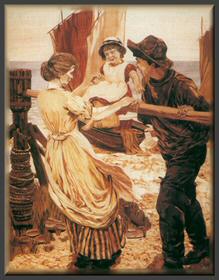 Detail from
Detail from
"Capstan Fun" |
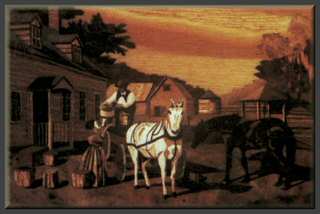
Preparing for Market
|
C: Everyone seems to have a different way of planning a piece of work. How do you go about planning the initial stages of a new piece of work? e.g. If working from a coloured picture do you also take a monochrome copy to look at tonal range?
Patrick: Nowadays I work from a coloured picture. My 'Heath Robinson' press can take pictures up to 33" x 20", so this restricts me to size. I decide on the size and have coloured photocopies to that size. I break the picture down to easy to work with sections and start with what I think is the most difficult part of the picture. With people pictures it is usually the faces. When I'm satisfied with them I start on the background. I don't do much planning, I instinctively know what to do and just get cracking with the cutting and hope I've got enough veneers to do the job. Very occasionally I'll do a picture from a black and white photo and make up my own colour scheme, but I much prefer to work from coloured photocopies.
|
C: What makes you choose to do any particular piece of marquetry? Is it for yourself, a present, because it is a fascinating design or is it for the challenge?
Patrick: I choose pictures I like, but occasionally my three daughters want a particular picture, 'Harrymal' (Gt. Yarmouth, 1995) the tiger picture for instance.
When I did 'One Cool Cat' (Bexleyheath 2005) they wanted that, so I've got to do one more good tiger picture so that they can have one each. Such is life.
I do like a challenge, but I am very limited by the amount of veneer I have.
I don't do many outdoor pictures because I haven't got veneers that depict a good cloudy looking sky. When I see some of the beautiful sky and other veneers used by other marquetarians I'm envious.
I often say to my wife Margaret "If I had veneers like that I could do a real masterpiece of the outdoors".
|
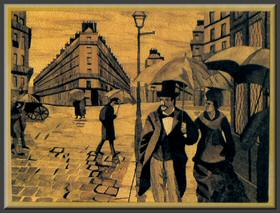 A Rainy Day in Paris
A Rainy Day in Paris
|
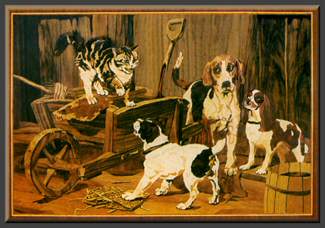
The Cat at Bay
version 1 (1988)
|
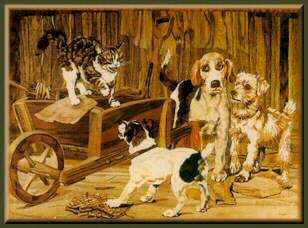
The Cat at Bay
version 2 (1998)
|
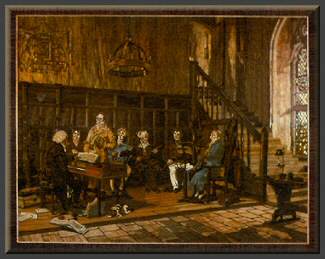 The Rehearsal
The Rehearsal
|
C: Marquetry does change in methods and style, albeit slowly, so what changes have you seen changes since you started and have you adapted your own work to follow any of those changes?
Patrick: I've seen many changes over the years, from using brown sticky paper to hold the picture together to no sticky paper, just relying on P.V.A. glue rubbed into the joints to hold it together before pressing.
From cutting from the back, the glued down side, to cutting from the front, the face side.
From using large pieces of veneer to using slivers. From using Scotch glue, heated in a pot, to the modem glues.
From, dare I say it, the fretsaw to the knife.
When I see what I think is a better or quicker method I adapt it.
|
C: You are well known for producing your beautiful detailed pictures but you do not appear to have turned your skills to the applied field. Is there a reason for this?
Patrick: I don't do many applied pieces. I don't have a workshop. I feel you need a workshop and machines to do applied work on any scale. I gave up working machines after my day job and now that I'm retired I stick to that rule. More pleasure is derived working on the table in the Living Room, doing a picture.
C: Is marquetry a definite relaxation for you?
Patrick: The pace of life today is very fast and everything is wanted in a hurry, people to meet, places to go etc. For me marquetry is another way to use wood and show off its beauty. It has to be done at a leisurely pace. It slows me down and helps me to relax. A little music - Acker Bilk or Mantovani whilst mulling over a picture and the troubles of the world disappear. |
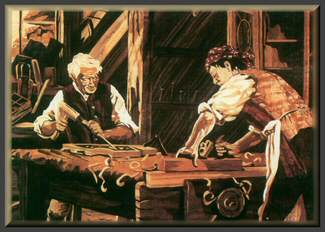 The Craftsmen
The Craftsmen
|
C: Marquetarians nearly always have a piece of work that is a favourite.
Can you pick such an item, from all your work that has given you most satisfaction?
Patrick: I've enjoyed doing all my marquetry; often I see flaws in my pictures and can see ways of improving them, especially my favourite ones, so I have another go at them.
One such picture is 'The Craftsmen' (1986).
My second attempt ( Thurrock 1997) at it was much improved and since it was about my own craft, this is my favourite picture.
It reminds me of some of the workshops I've been to and worked in.
|
C: Has there been any piece of work, made by any other member, which has left you thinking I wish I had done that?
Patrick: No, I have admired many pieces of work but I've never felt like doing them.
C: Which of your Rosebowl wins has given you the most satisfaction and why?
Patrick: Naturally the first one 'The Winning Card' ( Wales 1992) must be the one.
I've always felt my type of picture, especially the indoor types, with no freak markings or unusual figuring in the veneers were not Rosebowl contenders.
When I got the result from Pat Austin, over the phone, I was speechless for a while, so much so that Patricia, I am sure, thought I had collapsed!
C: Which Rosebowl winner by another person has created the biggest impact on you and why?
Patrick: Having only been to about nine Nationals, I can only comment on the ones I have seen at close quarters.
The one that had most impact on me was 'Wilderness Man' by Alan Townsend ( Winchester 1996).
The cutting and blending of the veneers for the fur, feathers, face, background and borders was brilliant.
A true masterpiece.
C: Have you keep all your creations?
Patrick: No, I've given away a lot of pictures as presents but I have kept my favourite ones.
They will, hopefully, become family heirlooms.
|
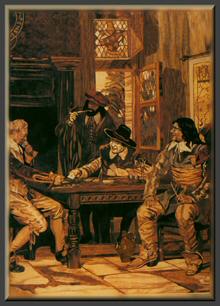 The Winning Card
The Winning Card |
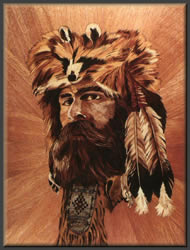 Wilderness Man
(by Alan Townsend)
Wilderness Man
(by Alan Townsend) |
|
 Mallard
Mallard
|
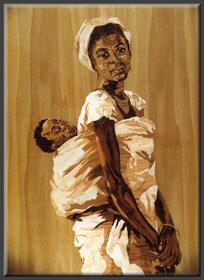 African Woman and Child
African Woman and Child
|
C: Do you have any other crafts, hobbies or interests, which share your available time?
Patrick: Sure, I have lots of interests apart from marquetry, horse racing, music, and reading. My wife Margaret and I also enjoy walking in our beautiful countryside. We go to car boot sales; Margaret is interested in collecting ceramics, while I keep my eye out for wooden bargains. Lots of my time is taken up doing joinery work for family and friends. I seem to be in constant demand. Charging nothing for my services has something to do with it! We also spend a lot of time with our four Grandchildren.
C: What is your stance on the long-standing debate about marquetry being an art or a craft and do you think that we should pursue the status of being called an art?
Patrick: I've aired my views in the 'Marquetarian' often enough about this. For me marquetry is mostly craft with a little bit of art. I am enjoying myself so I don't worry whether people call it art or craft, but we can't get away from the fact that marquetry is a visual art form and can possess aesthetic value. |
C: The ‘for or against coloured wood’ argument has gone on for years and you have acquired a degree of notoriety on your dislike of the use of coloured woods.
What are your views on it?
Patrick: Coloured woods fade badly with time, unless of course they are kept in the dark.
I am not against coloured woods if they are used tastefully.
They are so garish they don't often blend in with naturally coloured veneers.
If a picture is made from all coloured woods,
you can't see the grain in the wood,
it is obscured by the dye.
The object of marquetry, in my book, is to show off the beauty of the wood.
C: Do you do much judging and do you enjoy it?
|
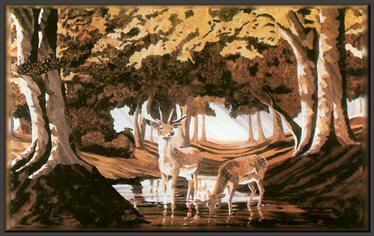
Woodland Harmony
|
Patrick: As far as marquetry is concerned I have only judged at the Ipswich National in 1993. However, I have had plenty of experience of examining woodwork in the building industry and as an instructor in carpentry and joinery. I don't really enjoy judging other peoples work, too often it leads to friction. I did enjoy judging and the camaraderie at the Ipswich National, but I prefer to compete.
C: Would you like to see ‘Judges comments’ reintroduced for the National award winners?
Patrick: Yes I would like to see' Judges comments' reintroduced. I've always found comments about my own pictures useful and if I decide to do a favourite picture again, I pay heed to them, I don't take umbrage. Yes our ego is dented for a short while, so what, we are all competing and striving to do the best we can. Mind you a little praise along with the faultfinding would help.
 The Start
The Start |
C: What is the first thing you look for when judging an entry at any level? Is it artistic impact or technical workmanship?
Patrick: I judge artistic impact, overall appearance, good tonal balance and choice of veneers first, then the technical workmanship, cutting, finish etc.
C: Have you ever had an embarrassing or humorous moment when you were judging?
Patrick: No embarrassing moments at judging marquetry, but one embarrassing moment when someone phoned me and said; "I believe you are the person to speak to about marquetry in Scotland", and then went on to ask me if! would do a portrait of Adam Smith in wood.
I knew three Adam Smiths, so I asked which one.
He said "The economist". I then asked him to send me a coloured photograph of him.
There was silence and the phone went dead!
Of course what I didn't realize, it was Adam from 200 years ago.
I found it very embarrassing yet humorous.
|
C: Do you think that there is any case for introducing any other media into marquetry, e.g. pyrography?
Patrick: No, I don't think so, once you allow one other medium, the floodgates open and all sorts of crafts jump on the bandwagon.
C: Do you think the National should remain a competitive exhibition? If not what would you replace it with?
Patrick: Definitely, the standard of marquetry has improved over the years and I feel it is due to competition. It makes you strive to do better..
C: Do you think the craft could or should be promoted in a more positive fashion?
Patrick: It costs money to promote anything, but if we are not positive in our thinking, we are lost.
C: Thank you Patrick.
|
|

![]()

![]()